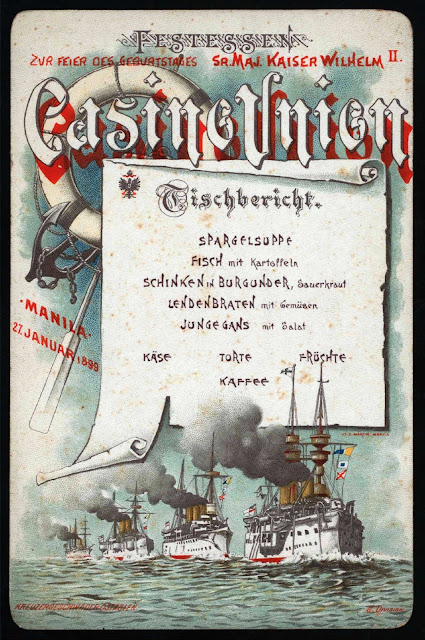Germany's Colonial Ambition In the Philippines 1898
The Pacific Ocean was once considered a Spanish lake, serving as the "camino real" or royal road for Spanish commercial activities between the Americas and Asia from the 16th to the 19th century. The Caroline Islands, Palau, the Mariana Islands, including Guam, were part of the Spanish East Indies, which were administered by Manila. These islands were also considered a remote outpost for Spaniards working for the Ministry of Overseas Territories (Ministerio de Ultramar). Filipino recruits in the Spanish colonial armies were noted to have served on some of these islands, with one particular account mentioning service on the island of Ponape. Additionally, Guam served as a place of exile for Filipino dissidents.
Spanish Decline in the Pacific
In the latter half of the 19th century, European powers began to take an interest in the Pacific, recognizing the weakening Spanish control. Germany started to assert its presence in the Western Carolines, which provoked a protest from Spain. This led to a diplomatic debate known as the "Karolinenfrage" (Carolines Question), where Germany challenged Spain's sovereignty due to its lack of effective presence, while Spain countered by citing its centuries-long hold on the islands. This period marked the decline of Spain as a global power, which was evident as other European nations sensed Spain's vulnerability.
Spain countered Germany's growing interest in the Pacific by staging an elaborate exhibition that showcased its Pacific possessions at an international fair in Madrid. The Madrid Exposition of 1887, conceived by Victor Balaguer, the Spanish Minister of Overseas Colonies (Ministerio de Ultramar), aimed to bring attention to Spain's holdings in the region. Balaguer, who had previously advocated for Filipino representation in the Spanish Cortes, organized the exposition to highlight not only native Filipinos, such as the Igorots, and Filipino talents in arts, flora, and fauna, but also other Pacific Islanders under Spanish rule, including the Chamorros and Micronesians. The exposition was also an international display intended to counter the growing influence of Germany in the Pacific, particularly in the Western Caroline Islands, as Spain's hold on these territories was becoming increasingly precarious due to German ambitions in the region.
German Maneuvering in Manila Bay
After the Spanish fleet's defeat by Dewey's American squadron in Manila Bay, Berlin dispatched its East Asia Squadron (Ostasiatische Kreuzergeschwader) under the command of Admiral Otto von Diederichs to the Philippines. The squadron's mission was to protect German interests and, if possible, secure a colonial concession in the Philippines.
It took some time for von Diederichs to assemble his fleet, but by mid-June 1898, the German squadron, consisting of five ships (SMS Kaiser, SMS Irene, SMS Cormoran, SMS Kaiserin Augusta, and SMS Prinzess Wilhelm), arrived at the entrance of Manila Bay, posing a serious challenge to the American fleet. In response, Dewey imposed a naval blockade not only against the Germans but also against other foreign warships from Great Britain, France, and Japan lurking in Manila Bay. The Germans continued to provoke by violating Dewey’s blockade, bringing in supplies to the trapped Spaniards, and treating sick Spanish residents aboard their vessels.
Tensions escalated when the German gunboat SMS Cormoran refused to acknowledge American signals to be boarded for inspection, prompting the Americans to fire a warning shot across its bow. Von Diederichs responded by sending an officer to complain about Dewey’s provocative actions. This incident nearly led to an exchange of fire between the Americans and Germans.
Germany's Island Acquisitions
Ultimately, realizing that Spain would not sell the Philippines to Germany and with the arrival of American expeditionary forces, Germany abandoned its colonial ambitions in the country. A few weeks later, the Treaty of Paris was signed, ending the Spanish-American War and marking the transition of the Philippines to American control.
In 1899, as a consequence of Spain's defeat in the Spanish-American War, several of its Pacific islands were sold and transferred to German control. Among these islands was Ponape (Pohnpei), which became the site of a notable conflict. This incident involved a garrison battle between a Spanish detachment, composed mainly of native Filipino conscripts, and German forces. The conflict arose because the Spanish officer in charge of the detachment was unaware that a treaty had already been signed, selling the islands and transferring the sovereignty of Ponape to Germany.
 |
| Admiral Otto von Diedrichs (1843-1818). Commander of the "Ostasiatische Kreuzergeschwader" or East Asia Squadron that was sent to Manila Bay 1898 (Photo -"Das Bundesarchiv") |
 |
| SMS Kaiser 1874 later renamed "Uranus" (Photo courtesy www.kaiserliche.marine.de) |
 | |
SMS Irene
|
 |
| SMS Cormoran |
 |
| Deutsche Marine Schiffspost. Postcard featuring Malacañang Palace sent by a sailor from the German fleet in Manila 1898. |



.png)


Comments
Post a Comment